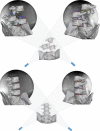Influence of weight-bearing on the 3D movement of lumbar facet joints in the sitting position
- PMID: 37430257
- PMCID: PMC10331990
- DOI: 10.1186/s12891-023-06698-y
Influence of weight-bearing on the 3D movement of lumbar facet joints in the sitting position
Abstract
Objective: To analyze the motion characteristics of lumbar facet joints and to observe the effect of weight-bearing on lumbar facet joints in the sitting position.
Methods: Ten normal subjects (5 males and 5 females) were recruited and scanned by CT, and their lumbar 3D models were reconstructed by software. The images of flexion and extension of lumbar facet joints in the sitting position were collected without weight-bearing and weight-bearing 10 kg, and the 2D model was constructed by software. The 2D-3D model was matched to restore the flexion and extension motion changes of the subjects' lumbar spine in the sitting position. Coordinates were established in the middle of the vertebral body and copied to the facet joints. Measure and record the lumbar facet joint movement distance through coordinate system. The relevant data of facet joints were collected.
Results: In the L3/4 segment, after weight loading, the displacement of the left facet joint in the X axis became larger, while that in the Y axis and Z axis decreased. The displacement of the right facet joint in the X axis and Y axis increased, and the Z axis displacement decreased. The rotation angle of the bilateral facet joints also decreased. In the L4/5 segment, after loading, the displacements of the X, Y, and Z axis displacements of both sides increase, while the rotation angles of α and β increase, while the rotation angle of γ decreases. In the L5/S1 segment, the displacements of the X, Y, and Z axes on the left side decrease. The displacement of the X and Y axes on the right side decreases, while the displacement on the Z axis increases. The rotation angles of α and γ increase, and the rotation angle of the β axis decreases.
Conclusion: When sitting, the flexion and extension distance and rotational displacement of lumbar facet joints are not affected by weight-bearing. In addition, there is asymmetry in the movement of the left and right facet joints, and weight bearing has no effect on the asymmetry of the motion.
Keywords: Lumbar facet joints; Lumbar, DFIS; Sitting; Weight-bearing.
© 2023. The Author(s).
Conflict of interest statement
The authors declare no competing interests.
Figures





Similar articles
-
3D kinematic characteristics of lumbar facet joints in sitting position.Surg Radiol Anat. 2022 Sep;44(9):1289-1295. doi: 10.1007/s00276-022-03005-7. Epub 2022 Aug 13. Surg Radiol Anat. 2022. PMID: 35962832
-
Effect of different loads on facet joint motion during lumbar lateral bending in sitting position.J Orthop Surg Res. 2024 Jan 13;19(1):61. doi: 10.1186/s13018-024-04533-1. J Orthop Surg Res. 2024. PMID: 38218824 Free PMC article.
-
The effect of various weight-bearing activities on the motion of lumbar facet joints in vivo.J Orthop Surg Res. 2022 Feb 21;17(1):114. doi: 10.1186/s13018-022-03016-5. J Orthop Surg Res. 2022. PMID: 35189913 Free PMC article.
-
Kinematic Characteristics and Biomechanical Changes of Lower Lumbar Facet Joints Under Different Loads.Orthop Surg. 2021 May;13(3):1047-1054. doi: 10.1111/os.12894. Epub 2021 Mar 11. Orthop Surg. 2021. PMID: 33709625 Free PMC article.
-
3D orientation and kinematic characteristics of zygapophyseal joints while sitting.Ann Transl Med. 2022 Apr;10(7):415. doi: 10.21037/atm-22-969. Ann Transl Med. 2022. PMID: 35530947 Free PMC article.
Cited by
-
Pediatric Solid-State 3D Models of Lumbar Vertebrae and Spine.Cureus. 2024 Apr 24;16(4):e58938. doi: 10.7759/cureus.58938. eCollection 2024 Apr. Cureus. 2024. PMID: 38800205 Free PMC article.
References
MeSH terms
Grants and funding
LinkOut - more resources
Full Text Sources

